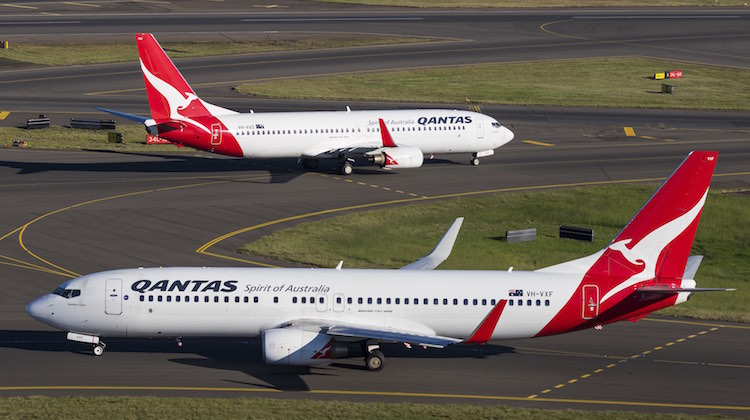 Qantas says it expects a decline in underlying profit before tax (PBT) and ongoing domestic capacity reductions after reporting a drop in revenue for the first three months of 2016/17.
Qantas says it expects a decline in underlying profit before tax (PBT) and ongoing domestic capacity reductions after reporting a drop in revenue for the first three months of 2016/17.
In its first quarter trading update, Qantas said underlying PBT for the six months to December 31 2016 was forecast to be in the range of $800 million to $850 million, compared with $921 million in the prior corresponding period.
“That range would represent the third-best first half result in Qantas’ history,” the company said on Monday.
Qantas said capacity across the airline group, measured by available seat kilometres (ASK), was now forecast to increase 1.5-2 per cent in the first half, compared with previously issued guidance of 2-3 per cent.
All of that increase will be in overseas flying, given Qantas said domestic capacity across both its Qantas and Jetstar airlines was expected to decline one per cent in the half.
Chief executive Alan Joyce said the airline group’s cost-reduction transformation program and flexible capacity management across its Qantas and Jetstar brands had the company well-placed to deliver a “strong first half profit result” for 2016/17.
“The group’s reduced cost base, disciplined financial framework, and portfolio strategy give us the foundations to keep performing well even in a more challenging international revenue environment,” Joyce said in a statement on Monday.
“Like most carriers globally, we are seeing international air fares below where they were 12 months ago, but the impact of that is tempered by the competitive advantages we’ve been working hard to fortify including our strong domestic position and diversified Loyalty business.”
Revenue across the airline group fell three per cent to $3.98 billion in the three months to September 30 2016, compared with $4.11 billion in the prior corresponding period.
Meanwhile, unit revenue, measured by revenue per available seat kilometres (RASK), fell 5.5 per cent in the quarter.
Qantas said the result was due to “increased competition on international routes and a subdued domestic demand environment in the first two months of the year”.
On a more positive note, Qantas said the domestic market had reverted to more stable conditions in September, following a couple of months of “demand softness” in July and August due to the federal election and other one-off events that positively impacted trading conditions in the prior year.
“Qantas Domestic, Jetstar Domestic and Qantas Loyalty all continue to perform well with high operating margins in a stable market,” Joyce said.
However, the resources market was continuing to act as a drag on RASK, which declined 2.9 per cent across Qantas and Jetstar in the first quarter.
Further, Qantas said there was a $28 million fall in resources market revenue in the first quarter, primarily from intra-Western Australia and Queensland.
The airline group has been redeploying aircraft out of domestic resources-related markets onto more profitable routes that have primarily been in international markets, as well as getting more out of the fleet through increased utilisation.
Qantas domestic ASKs were down 0.6 per cent in the first quarter, while Jetstar cut ASKs 2.4 per cent in the same period.
Meanwhile, Qantas lifted international ASKS 5.8 per cent, while Jetstar’s international capacity was up 4.3 per cent.
Qantas has added extra flights to New Zealand and plans to launch Melbourne-Tokyo Narita and Sydney-Beijing in the coming months. It has also scheduled some additional frequencies to its existing Asian network.
The company said those new international routes “continue to meet expectations though have lowered average international unit revenue during their ramp-up phase”.
International RASK across Qantas, Jetstar and Singapore-based Jetstar Asia fell 6.9 per cent in the quarter.
Qantas said its total fuel bill for the first half was expected to come in at $1.5 billion, down from $1.7 billion in the prior corresponding period.
For the full year, fuel costs were forecast to be $3.15 billion “and no worse than $3.2 billion”, based on a Brent crude forward market price of A$68 per barrel for the remainder of 2016/17.
“We remain disciplined on cost, continue to manage capacity carefully to match demand, and have secured the benefit of lower fuel prices through our hedging,” Joyce said.
“And at the same time, we will continue to invest in building the Group’s long term competitive advantages, including our brand, customer service and product.”
Qantas shares were up nine cents, or three per cent, at $3.03 in afternoon trade on the Australian Securities Exchange.
Macquarie Securities Australia analyst Sam Dobson said the first quarter report was weaker than anticipated, while the second quarter was expected to be better.
“While today’s quarterly data is worse than we had expected, capacity reductions (vs. previous planned growth) will aid in the recovery of unit revenues, specifically in Group Domestic,” Dobson said in a research note dated October 31.
In August, Qantas said it would start issuing quarterly trading updates in place of the previous monthly traffic statistics to “enhance market disclosure”.
Virgin Australia, which began issuing quarterly updates some years ago in line with one of its major shareholders Singapore Airlines (SIA), is expected to publish its first quarter trading update later in the week.










